The National Data Commissioner's Keynote Address to the 10th Annual Aus Government Data Summit
On 28 March, National Data Commissioner Gayle Milnes addressed the 10th Annual Aus Government Data Summit in a keynote speech.
Thank you for the invitation to speak at the Summit this morning.
Let me begin by acknowledging the traditional owners of the land on which we meet today, the Ngunnawal and Ngambri people, and pay my respects to their elders, past, present and emerging and extend that respect to First Nations people here today.
Australian Government data – a valuable national asset
For the many Australian Government officials in the audience, we are the custodians of a valuable national asset – data. Data about how Australians are faring, about our natural environment, about our economy. There are large integrated data assets like the Person Level Integrated Data Asset, aka PLIDA or formerly known as MADIP, and the Business Longitudinal Analysis Data Environment aka BLADE. These are administered by the Australian Bureau of Statistics. There’s the National Health Data Hub (formerly known as the National Integrated Health Services Information), the good work of the Australian Institute of Health and Welfare. Others are being developed such as the National Disability Data Asset and the Life Course Data Asset. These visuals give you a sense of the richness of the integrated data assets and their components.
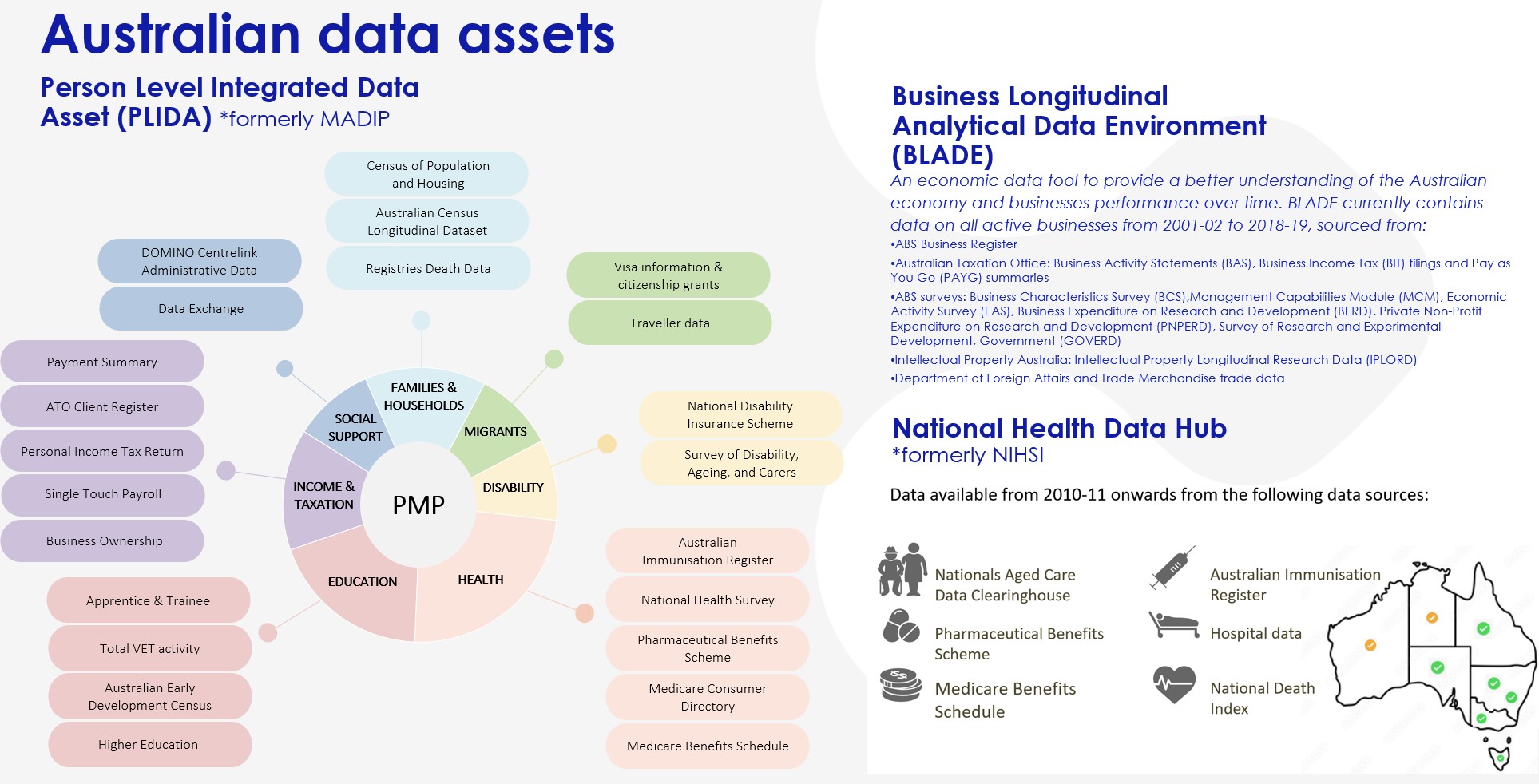
It was encouraging to see Australia ranked fifth in its first engagement with the Organisation for Economic Co-operation and Development’s recently released Digital Government Index survey. We’re up there with the best, surrounded by talented people making great use of data to identify and define the challenges we face, identify the best solutions, monitor implementation and the evaluate the actions taken.
Let me give you some examples of how your colleagues are using data well to deliver better policies, programs and services:
- Using national greenhouse gas and other data, the Government is introducing a New Vehicle Efficiency Standard which will help save Australians money at the petrol pump, giving Australians more choice about the cars they can buy, reduce transport emissions, and improve air quality. Look at the great visual from the Infrastructure Department, below.
- Data from the Australian Immunisation Register and the Person Level Integrated Data Asset (PLIDA) was used to inform the roll out of COVID vaccines. We achieved one of the highest rates of vaccination in the world helping us mitigate the impacts of the pandemic.
- Utilising data collected by the Australian Taxation Office through Single Touch Payroll and Business activity statements, the Government delivered JobKeeper stimulus payments of more than $89 billion to support individual Australians and business owners impacted by COVID-19 – all in record time and with a high level of program integrity.
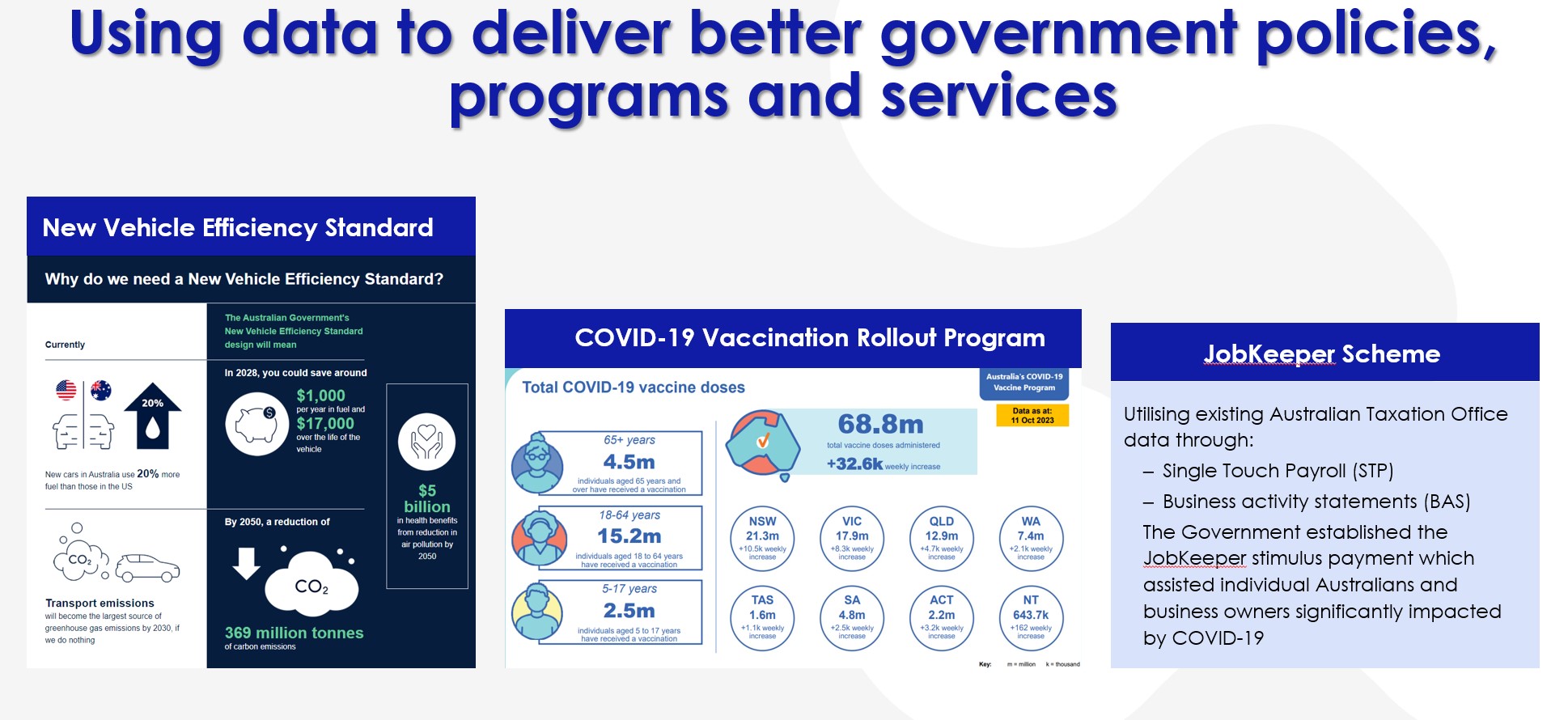
Increasing the availability and use of Australian Government Data
The new scheme for sharing data collected by Australian Government agencies – the DATA Scheme as we like to call it - sets us up to do even more with our data, to realise its full value and for future where you are best in class users and managers of data.

We call this new scheme the DATA Scheme because it is established by the Data and Availability Transparency Act 2022 which came into effect in April 2022. The Scheme is all about increasing the availability and use of data collected by Australian Government agencies to deliver public benefit – better government policies, programs and services, world leading research and development.
My role, supported by my office, is to oversee the Scheme, to provide advice and guidance to the Minister and Scheme participants about its operation and to deliver education and tools to support best practice data handling and sharing.
I’ll step you through some key points on how the Scheme operates.
There are three types of entities that are eligible to participate in the Scheme - Australian Government agencies; state and territory government agencies; and Australian universities. There are three roles they can play.
There’s the accredited data user who can request, collect and use data from an Australian Government agency – the data custodians. It could be a request from an NSW government agency to the Australian Government Department of Health and Aged Care, for example. Or from one Australian Government agency to another. The data may be shared directly or via an accredited data service provider, like the Australian Bureau of Statistics, who can provide data de-identification, integration and secure access services.
So what are the benefits of this Scheme? Why participate?
You can get access to valuable data held by Australian Government agencies. This includes data you have not been able to access before. This is because the Data Availability and Transparency Act 2022 authorises Australian Government agencies to share data they could not previously because of legal barriers.
The Scheme’s safeguards are another plus:
- only Australian entities can participate;
- sharing must be in the public interest and for one of three purposes – to deliver government services, to inform government policy and programs, or for research and development. Data cannot be shared for compliance purposes;
- to request, collect and use data, and to be a data service provider, you must be accredited. This ensures participants have the right data governance and management arrangements, ICT and other security settings and people capability to handle the data and minimising the risk of unauthorised access;
- data custodians have no duty to share but they are required to consider a request within a reasonable period and if they refuse a request, they must provide reasons in writing no later than 28 days after the decision was taken
- our guidance to Australian Government agencies is they should aim to acknowledge receipt within a week, request further information within two weeks, and respond within a month;
- a data sharing agreement that applies the data sharing principles – the right project, people, setting, data and output - must be in place before the data is shared;
- the Commissioner is required to keep public registers of the accredited participants and data sharing agreements and to report annually on the Scheme;
- the Commissioner regulates and enforces the Scheme through their regulatory functions. They include: accrediting Scheme participants, handling complaints, assessing and investigating Scheme entities, taking enforcement actions and transferring matters.
We have seen recent data breaches like Optus and Medicare and know the risk of cyber threats and foreign interference. The safeguards of the DATA Scheme ensure participants can handle the data and follow the Scheme’s best practices so data is shared and used ethically and in a way that protects people’s privacy, commercial sensitivities and national security.
The complaints mechanism provides a way to manage disputes between DATA Scheme entities (a Scheme complaint) and for any person to raise concerns with the operation and administration of the DATA Scheme (a general complaint). The complaints function is a form of redress available under the DATA Scheme, and a means for the Commissioner to identify potential cases of non-compliance and areas to improve or support implementation of the DATA Scheme.
Importantly, the safeguards help maintain and build public trust and confidence in the use of Australian Government data.
The consistent application of the Scheme’s best practices by participants, supported by the tools we have developed, will yield efficiencies. This is the third benefit.
Here I want to call out Dataplace. It is the digital platform we have built that brings together those wanting to access data with the data custodians. Some in my office say it is like a dating app, others describe it as the PDMS for data. I’ll let you make your own call on that!
Right now, you can use Dataplace to apply for accreditation, to make a request for data and finalise a data sharing agreement, as well as monitor and report on your data sharing activities. If you are an Australian Government agency, and you do not have a system for managing requests you receive for data, you can use Dataplace. If you are a state government agency or university, you can use Dataplace to see all the data requests your agency or researchers make of Australian Government agencies.
Alongside setting up the DATA Scheme and creating Dataplace, we have been building the Australian Government Data Catalogue to help users find data and rolling out the Data Inventories Pilot Program.
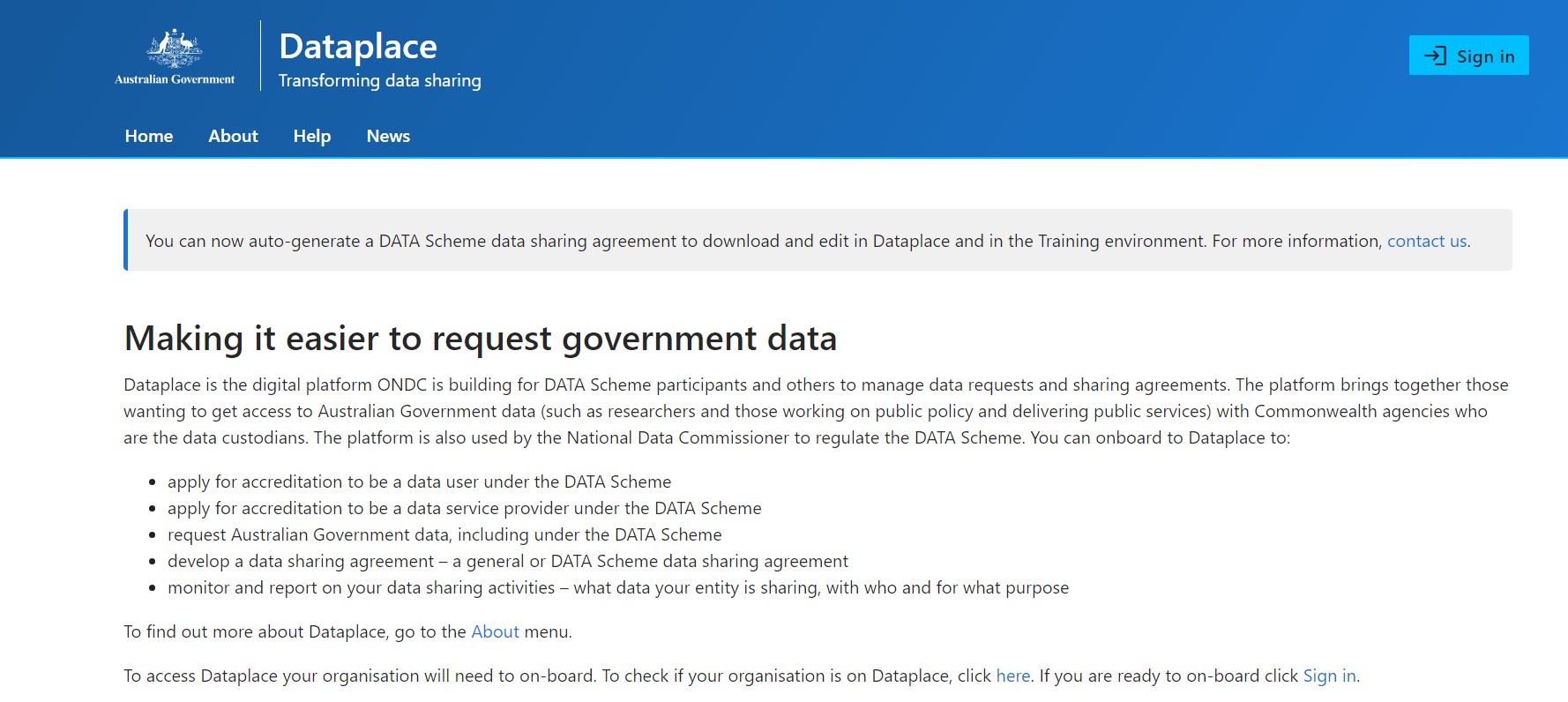
Under the Program, the ONDC has worked with Australian Government agencies to help them discover their data and to develop a standardised list of data assets they hold using a standard methodology - known as a data inventory.
These data inventories have common metadata attributes that are the base for a searchable catalogue of data assets held by Australian Government agencies. The Catalogue’s first release is due mid-year.
The Catalogue will be integrated with Dataplace providing a seamless service for discovering data, making a data request and sharing data.
Enabling sharing under the Scheme
I’ll turn now to uptake of the Scheme. I last addressed this Summit two years ago as the National Data Commissioner Designate. Just a few days after that we secured the passage of this transformational legislation with bipartisan support – a real game changer. A lot has happened in two years!
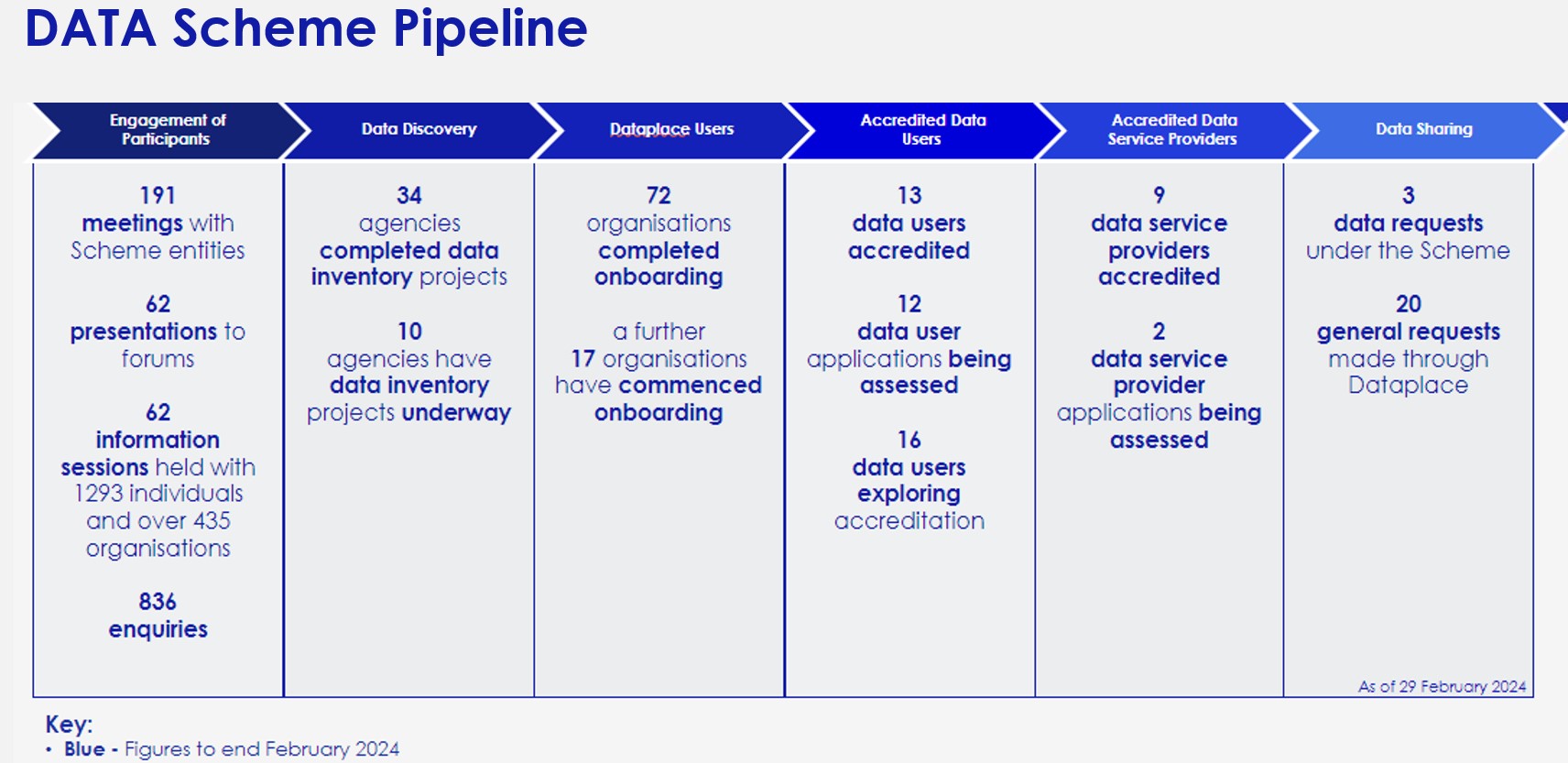
Our early focus was on laying the foundations, building the roads if you like, for all that makes sharing data safe and efficient:
- Growing the office and our capability to deliver our core functions
- Establishing the institutional arrangements and tools - such as Dataplace - to support best practice, efficient and transparent data sharing. 72 organisations have now onboarded to Dataplace.
- Strengthening data handling and use capability of Australian Government agencies. 34 agencies have completed their data inventory projects; 10 more are underway.
- We’ve been building awareness of the Scheme and supporting eligible entities to get accredited and begin sharing. There are now have 13 accredited data users with another 12 applications being assessed. We also have 9 data service providers accredited with a further 2 applications being assessed.
Encouragingly, we are seeing good engagement with the Scheme and some of the first data requests being made on Dataplace. There’s been 20 requests made so far with three under the DATA Scheme. The types of data requests are broad ranging – data on the Pharmaceutical Benefits Scheme, the Medicare Benefits Schedule, Commonwealth Rental Assistance and greenhouse gas emissions.
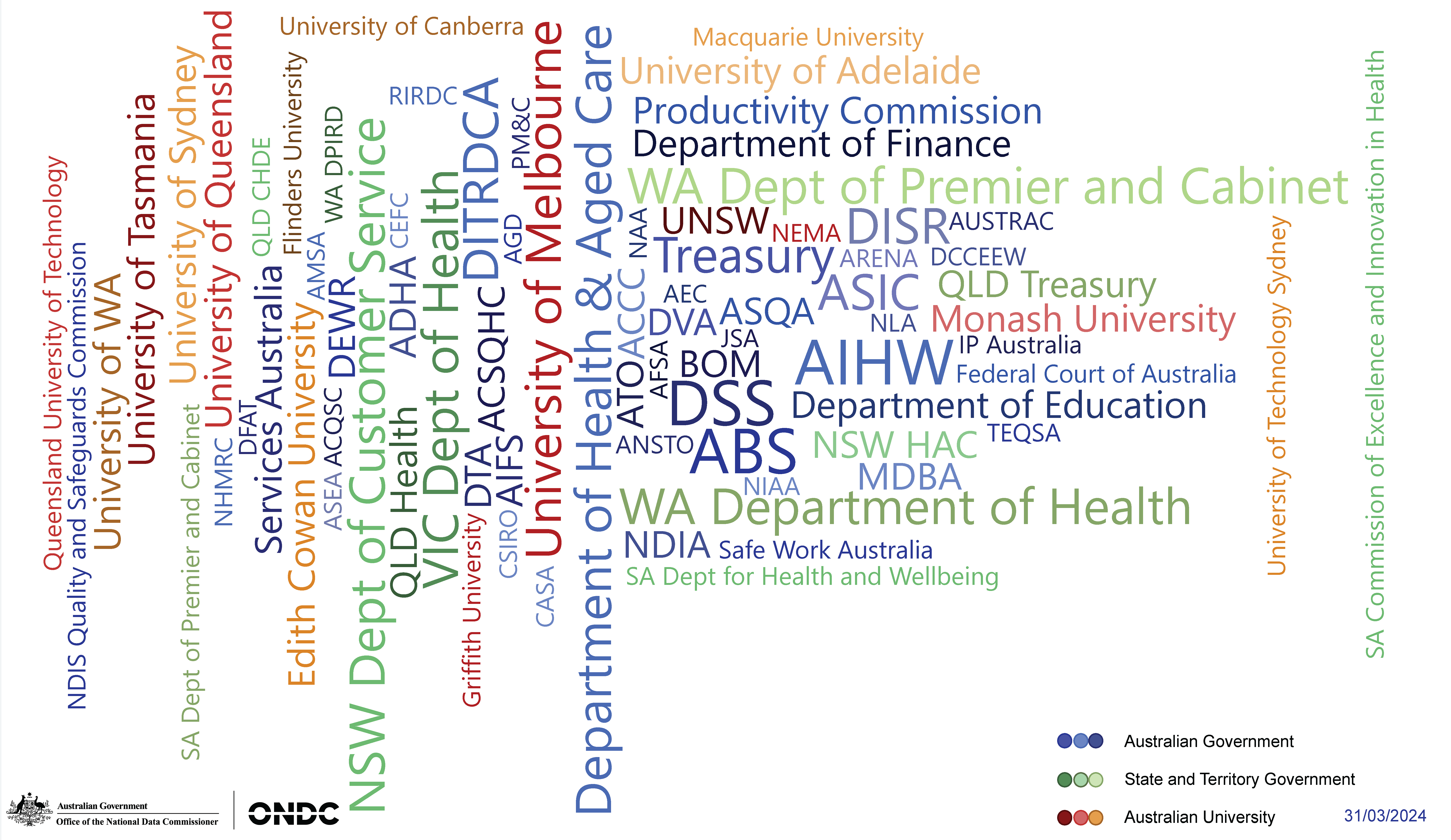
Start-ups have phases. We are transitioning now from the establishment to the operational phase. With our focus on enabling sharing under the Scheme, our three priorities are:
- to encourage and support uptake of the DATA Scheme. This is all about supporting you to make a request for data and getting access to the data. We are supporting and guiding government agencies to use the DATA Scheme, including to build the National Disability Data Asset – an initiative of all Australian governments working with the disability community that will help better support people with disability, their carers, and the community. To drive research and innovation, we are making it a priority to support universities to make their first data sharing requests.
- to accredit and monitor Scheme participants. We have grown and built the capability of our team so that we are now meeting, and in some cases beating our service level standards for assessing applications for accreditation – two months for data users and three months for data service providers. Our monitoring activities are supporting entities to meet their reporting and other obligations, in particular notifying the Commissioner of events or changes in circumstances affecting accreditation and complying with annual reporting requirements, conditions of accreditation and other legislative obligations.
- educating and guiding on best practice data handling and sharing. Our actions in this area include encouraging the use of the Scheme’s best practices when sharing public sector data even when organisations cannot or do not need to rely on the Act to authorise the sharing of data. Another priority is to help Scheme participants to minimise the risk of a data breach and mitigate harm from any breach.
We are learning a lot from working with Scheme participants and others to apply the legislation as well as from your feedback and complaints about how we are administering the DATA Scheme and limitations of the legislation.
We are making changes to improve our services. For example, in response to feedback, we have improved Dataplace - data users now have to indicate whether their request is a DATA Scheme request or a general request, making clear the data custodian’s obligations. We have streamlined our data sharing agreement templates and identified ways we can streamline the assessment of accreditation applications. We are preparing for the statutory review of the Act in 2025.
What you can do?
Get in touch with us at information@datacommissioner.gov.au. We can help you make a request for Australian Government data, get accredited, and onboard to Dataplace. You can use our guides to develop your organisation’s data inventory. You can help us link your organisation’s data inventory to the Australian Government Data Catalogue. You can join the webinars we hold each Wednesday in the middle of the month so you can learn more about the DATA Scheme and build your organisation’s data capability. On 17 April we will be hosting webinars on how to make a data request, how to respond to a data request, and how to develop and improve your organisation’s data inventory. Go to our website to register for the webinars and find our guidance and other resources. You can subscribe to my monthly newsletter, DataPoints. You can follow us on Linked in.
Another resource to commend to you is the APS Data Profession. It is open to all Commonwealth, state and territory government employees. You can join the members community platform. There are training opportunities. To secure the data staff you need, you can draw on the annual data graduate recruitment round. There is also the data capability framework that’s useful for workforce planning.
I’ll wrap up with a final request and that is to tell me about the good work you are doing with data – how you are using data to deliver value for our citizens – better government policies, programs and services as well as research and innovation. Your stories are important to help Australians understand how we are using their data to deliver better outcomes for them and build their trust and confidence in us.

